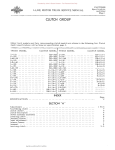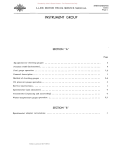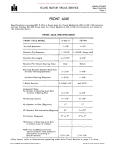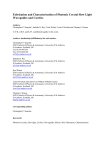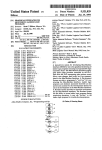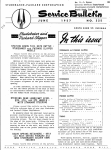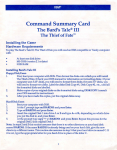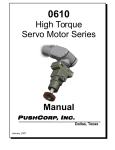Download Frame - Hansen Web Design
Transcript
Donated by John & Susan Hansen - For Personal Use Only L~LINE MOTOR TRUCK SERVICE MANUAL FRAMES Index Page 1 FRAME GROUP SECTION "A" Page F:rame alignment • • • . . . . . . • • . . . . . . . . . • . • . . . . . . • . • . 1 Checking frame alignment. • • . . . . . • . • . • . . . . . • . . . . • . . . • • . . . . . • . • . . . • . 1 Axle alignment with frame • . . 1 Frame strai~htening •.••..• PRIN1'£O IN UNITEO $TATf:S OF AMERICA 2 Donated by John & Susan Hansen - For Personal Use Only Donated by John & Susan Hansen - For Personal Use Only FRAMES L-UNE MOTOR TRUCK SERVICE MANUAL Section A Page 1 FRAMES Frame Alignment 3. Measure distance froIn center line to oppo site points Inarked over entire length of fraIne. MeasureInents should not vary Inore than 1/8" at any point. Any vehicle that has been in an accident which Inight result in a bent or sprung fraIne should have the fraIne and axle alignInent care fully checked. 4. Measuring diagonals, A-A, B-B, C-C, D-D will indicate point where InisalignInent oc curs. If diagonals in each pair check with 118", that part of fraIne included between points of IneasureInent Inay be considered in satisfactory alignInent. These diagonals should intersect within 1/8" of center line. Checking Frame Alignment A satisfactory Inethod of checking the fraIne and axle alignInent, particularly when a body and cab is on a chassis, is to Inark on a level floor all points at which IneasureInents are to be taken. Tack or ceInent pieces of paper to the floor directly under each point of Ineasure Inent on the chassis as indicated by the letter "K" in the various figures. The points of Ineas ureInent Inust be accurately Inarked in relation to the fraIne in order to obtain a satisfactory alignInent check. Axle Alignment with Frame After deterInining that fraIne is properly aligned, the axle alignInent with the fraIne should be checked by cOInparing diagonals. DiInensions for side elevation of frame should be checked at the points indicated and should not vary Inore than 1/8". After each IneasureInent point has been carefully Inarked on the floor, proceed as fol lows: Cutting, Reinforcing, Riveting and Welding 1. Locate center line of chassis by Ineasuring front and rear end widths, using Inarks on floor. If fraIne widths check, draw center line on floor, full length of chas sis. If fraIne widths do not check, layout center line as follows: 2. Whenever it is necessary to cut the fraIne, the side rail should be cut at an angle of 45 degrees. This Inethod distributes the cut and weld over a greater area than a cut Inade at right angles with the rail. ReinforceInents can be Inade with flat, channel, or angle stock. Because of difficulties encountered when inserting channel reinforce Inents into fraIne side rails, the use of angle reinforceInents is acceptable. Wherever pos sible the reinforcement should extend froIn the Center line can be drawn through the inter section of anyone pair of equal diagonals (A-A, B-B, C-C, D-D) and center point of one end of fraIne or through points of inter s ection of any two pai r s of equal diagonals. K H --~ ------1""" _-- K //--- K // A/ / " / " / ./ ./ , , , 'A, , , ""-"- / / / , / " / / / / "" / "- B / ""- "- ", / "B ""- K / / / / / / D / C / C " " / K A-22709 Fig. I - Frame and Axle Al ignment Checking Diagram. PRINTEO IN UNITED STATES OF AMERICA Donated by John & Susan Hansen - For Personal Use Only FRAMES Section A Page 2 L-LINE MOTOR TRUCK SERVICE MANUAL '~C=:::-') L-150-FRAME ILLUSTRATED A·22i'10 Fig. 2 - Frame and Axle Alignment Checking Diagram. front axle to slightly beyond the rear spring front mounting bracket as shown in illustration below. This. procedure, of course, may be impractical in some instances because of the position of attached units and existing cross members. The reinforcement thickness should not exceed that of the side rail to be reinforced. Whereverpossible,parts should be secure ly riveted together. Hot rivets are acceptable, as they can be more easily driven with hand tools. Cold rivets should only be used where tools of sufficient power to properly set the rivets are provided. Electric arc-welding is recommended for all frame welding. The heat of the weld is lo calized and burning of material is minimized when this method is used. In addition to thoroughly welding the cut in the side rail, the outside edges of the reinforce ments should be welded to the frame after the reinforcements are riveted. All unused holes should be filled with welding material. Welding rod should be substantially the same material as that used in the frame. The diameter of the reinforcement rivets depends upon spacing and the number of rivets used. Generally, rivets should be from 50% to l0010 as heavy in diameter as the total thick ness of the plates to be riveted. Frame Straightening Use of heat is not recommended when straightening frames. Heat weakens structural characteristics of frame members and all straightening should be done cold. Frame mem bers which are bent or buckled sufficiently to show cracks or weakness after straightening, should be replaced, or reinforced. Inverted "L" type frame reinforeeme~i A-22'l2'l Fig. 3




